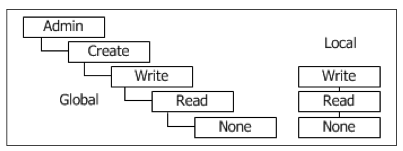User Management
The user management defines which permissions are required by a user to perform a database command or XQuery expression.
Permissions are mostly relevant in the client/server architecture, as the Graphical User Interface and the Command-Line Interface are run with admin permissions. There are a few exceptions, such as the xquery:eval function: Its execution scope can also be limited by specifying a permission.
Please take care of usual security measures: ensure that your password will not end up in your command-line history, avoid sending passwords via ordinary REST requests, etc.
Rules
In the permission hierarchy below, the existing permissions are illustrated. A higher permission includes all lower permissions. For example, all users who have the write permission assigned will also be able to execute commands requiring read permission.
Local permissions are applied to databases. They have a higher precedence and override global permissions.

Usernames must follow the valid names constraints, and the database patterns must follow the Glob Syntax.
Operations
Note that a running BaseX instance will not get notified of changes when you change the permissions with a standalone instance of BaseX (see Concurrent Operations for more details).
For all operations, admin permissions are required:
Commands
Create new user test:
$ basexclient
Username: admin
Password: ...
> CREATE USER testChange password of user test to 71x343sd#:
> ALTER PASSWORD test 71x343sd#Grant local write permissions to user test:
> GRANT write ON unit* TO testtest user will only be allowed to access (i.e., read and write) databases starting with the characters unit. If no local permissions are set, the global rights are inherited.
Show global permissions:
> SHOW USERSXQuery
Various User Functions exist to organize users and their permissions:
Create user test with no permissions:
user:create('test', 'top-secret')Show detailed information about user test:
user:list-details()[@name = 'test']Drop user test:
user:drop('test')Storage
The permission file users.xml is stored in the database directory. This file can be manually edited; it will be parsed once when BaseX is started.
Salted SHA256 hashes are used for authentication (the current timestamp will be used as salt). Additionally, digest hashes are used in the client/server architecture and the Clients, and in the HTTP Context if AUTHMETHOD is set to Digest.
Changelog
Version 8.0- Added: Revised in Version 8.0.